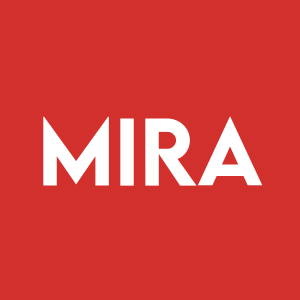MIRA Pharmaceuticals Initiates Multiple Ascending Dose (MAD) Phase 1 Study of Oral Ketamir-2 and Selects Chemotherapy-Induced Neuropathic Pain as Lead Phase 2a Indication
Rhea-AI Summary
MIRA (NASDAQ:MIRA) announced initiation of the multiple ascending dose (MAD) portion of its Phase 1 trial for oral Ketamir-2 in healthy volunteers and selected chemotherapy-induced peripheral neuropathy (CIPN) as the lead Phase 2a indication on October 24, 2025.
The randomized, double-blind, placebo-controlled study follows completed single ascending dose (SAD) dosing with no serious or dose-limiting adverse events reported to date. MAD cohorts will test repeat daily doses from 150 mg to 600 mg for five days. Pharmacokinetic analyses will be performed after unblinding. Preclinical and peer-reviewed data reported near-complete normalization of pain in a paclitaxel model and superiority versus ketamine, gabapentin, and pregabalin in animal neuropathic pain models.
Positive
- MAD Phase 1 portion initiated in healthy volunteers
- SAD completed with no serious or dose-limiting adverse events
- MAD dosing range defined: 150 mg–600 mg daily for five days
- Preclinical PTX model showed near-complete normalization of pain
Negative
- No human efficacy data reported yet from Phase 1
- Pharmacokinetic characterization pending unblinding
- Phase 2a for CIPN is planned but not yet initiated
News Market Reaction 1 Alert
On the day this news was published, MIRA declined 3.23%, reflecting a moderate negative market reaction. This price movement removed approximately $942K from the company's valuation, bringing the market cap to $28M at that time.
Data tracked by StockTitan Argus on the day of publication.
Advancing toward Phase 2a clinical evaluation in chemotherapy-related pain, a condition with no approved treatments and potential for FDA Fast Track consideration
MIAMI, FLORIDA / ACCESS Newswire / October 24, 2025 / MIRA Pharmaceuticals, Inc. (NASDAQ:MIRA) ("MIRA" or the "Company"), a clinical-stage pharmaceutical company developing novel oral therapeutics for neurologic, neuropsychiatric, and metabolic disorders, today announced the initiation of the multiple ascending dose (MAD) portion of its ongoing Phase 1 clinical trial evaluating its lead oral candidate, Ketamir-2, in healthy volunteers. The Company also announced that it has selected chemotherapy-induced peripheral neuropathy (CIPN) - a common and debilitating side effect of cancer treatment - as the lead indication for its planned Phase 2a clinical evaluation.
Phase 1 Progress
This milestone follows the completion of dosing in the single ascending dose (SAD) portion of the study. According to data reviewed to date, no serious or dose-limiting adverse events have been observed, and no clinically significant safety concerns have been reported. Comprehensive pharmacokinetic analyses will be performed following unblinding to further characterize Ketamir-2's absorption and half-life profile.
The ongoing randomized, double-blind, placebo-controlled Phase 1 study is evaluating single and multiple oral doses of Ketamir-2 to assess its safety, tolerability, and pharmacokinetics in healthy volunteers. The MAD portion includes three cohorts of repeat daily oral dosing (150 mg to 600 mg for five days), building on the safety and PK data from the SAD phase.
Peer-Reviewed and Preclinical Data Support Ketamir-2's Promise in Chemotherapy-Related Nerve Pain
Ketamir-2's advancement is supported by a growing body of preclinical and peer-reviewed research demonstrating efficacy in validated neuropathic pain models.
In a poster presented at the Pain Therapeutics Summit in Boston and a peer-reviewed article published in Frontiers in Pharmacology titled "Oral Administration of Ketamir-2, a Novel Ketamine Analog, Attenuates Neuropathic Pain in Rodent Models via Selective NMDA Antagonism," Ketamir-2 was shown to outperform ketamine, gabapentin, and pregabalin across gold-standard models of neuropathic pain.
In the well-established paclitaxel (PTX) chemotherapy-induced neuropathy model, Ketamir-2 produced near-complete normalization of pain sensitivity and demonstrated greater efficacy than gabapentin, the current FDA-approved standard for neuropathic pain. Additional studies showed superior performance versus ketamine and pregabalin in restoring sensory function in sciatic nerve ligation models, supporting its potential as a next generation, non-opioid therapy.
About Chemotherapy-Induced Peripheral Neuropathy (CIPN)
CIPN is a painful nerve damage condition caused by certain chemotherapy drugs that leads to persistent pain, tingling, numbness, and burning sensations, most commonly in the hands and feet. It affects up to 70 percent of cancer patients during treatment (source), and for many, symptoms continue long after therapy ends, often limiting their ability to complete potentially lifesaving chemotherapy.
Despite its impact, there are no FDA-approved treatments for CIPN. Physicians typically use off-label antidepressants, anticonvulsants, opioids, or ketamine infusions, each with limited and inconsistent benefit and significant side effects. This unmet need represents a global market estimated near
Why Ketamir-2 Could Fill a Major Gap
While ketamine has shown pain-relieving effects, its clinical use is limited by the need for intravenous administration, short duration of action, and undesirable psychoactive effects.
Ketamir-2 was designed to overcome these limitations as a novel, non-scheduled oral analog of ketamine with:
Good oral absorption and once-daily dosing convenience
No hallucinogenic or dissociative effects
Strong preclinical efficacy and favorable safety data supporting continued development
These features position Ketamir-2 as a potentially safe, oral, non-opioid candidate to address the large unmet need in chemotherapy related nerve pain and broader neuropathic pain indications.
Given the absence of FDA-approved treatments for chemotherapy-induced neuropathic pain and the high medical unmet need in oncology supportive care, the Company believes Ketamir-2 may qualify for consideration of regulatory incentives such as Fast Track designation.
Management Commentary
"We view Ketamir-2 not only as a promising clinical asset but as a potential value-creating platform for MIRA and our shareholders," said Erez Aminov, CEO of MIRA. "Our preclinical and clinical findings suggest that Ketamir-2 could represent a differentiated, non-opioid approach in a multi-billion-dollar pain market where effective therapies simply don't exist. Advancing this program through Phase 2a development positions MIRA to address a major medical and commercial opportunity while maintaining our disciplined, data-driven approach."
Dr. Itzchak Angel, Chief Scientific Advisor of MIRA, added: "The combination of clean pharmacology, good oral bioavailability, and robust preclinical efficacy sets Ketamir-2 apart from existing therapies. We look forward to completing the ongoing Phase 1 study and advancing its Phase 2a clinical evaluation in neuropathic pain."
About Ketamir-2
Ketamir-2 is a proprietary, orally bioavailable new molecular entity that selectively targets the NMDA receptor (PCP site) with low affinity and shows no significant off-target activity. Preclinical data support its potential in neuropathic pain, PTSD, and depression, without the dissociative effects associated with ketamine. The U.S. Drug Enforcement Administration has determined that Ketamir-2 is not classified as a controlled substance under the Controlled Substances Act.
About MIRA Pharmaceuticals, Inc.
MIRA Pharmaceuticals, Inc. (NASDAQ:MIRA) is a clinical-stage pharmaceutical company focused on developing and commercializing novel oral therapeutics for neurologic, neuropsychiatric, and metabolic disorders. Its pipeline includes innovative drug candidates targeting major unmet needs in neuropathic pain, inflammatory pain, obesity, addiction, anxiety, and cognitive decline.
Cautionary Note Regarding Forward-Looking Statements
This press release and the statements of MIRA's management related thereto contain "forward-looking statements," which are statements other than historical facts made pursuant to the safe harbor provisions of Section 27A of the Securities Act of 1933, as amended, and Section 21E of the Securities Exchange Act of 1934, as amended. These statements may be identified by words such as "aims," "anticipates," "believes," "could," "estimates," "expects," "forecasts," "goal," "intends," "may," "plans," "possible," "potential," "seeks," "will," and variations of these words or similar expressions that are intended to identify forward-looking statements. Any statements in this press release that are not historical facts may be deemed forward-looking. Any forward-looking statements in this press release are based on MIRA's current expectations, estimates, and projections only as of the date of this release and are subject to a number of risks and uncertainties (many of which are beyond MIRA's control) that could cause actual results to differ materially and adversely from those set forth in or implied by such forward-looking statements, including related to MIRA's potential merger with SKNY Pharmaceuticals, Inc. These and other risks concerning MIRA's programs and operations are described in additional detail in the Annual Report on Form 10-K for the year ended December 31, 2024, and the Form 14A filed by MIRA on June 18, 2025, and other SEC filings, which are on file with the SEC at www.sec.gov and on MIRA's website at https://www.mirapharmaceuticals.com/investors/sec-filings. MIRA explicitly disclaims any obligation to update any forward-looking statements except to the extent required by law.
Contact:
Helga Moya
info@mirapharma.com
(786) 432-9792
SOURCE: MIRA Pharmaceuticals
View the original press release on ACCESS Newswire








